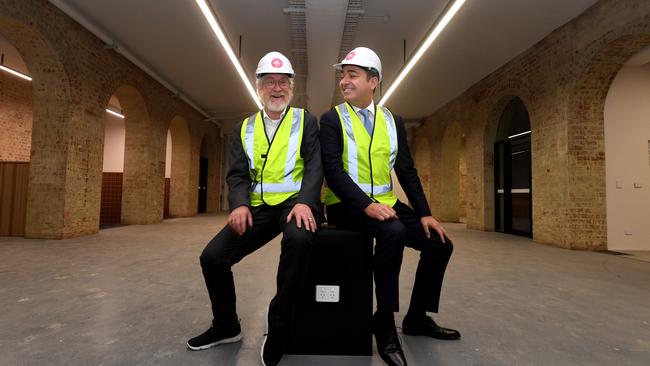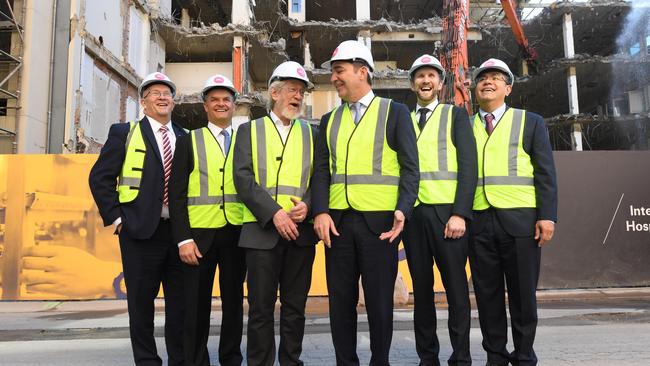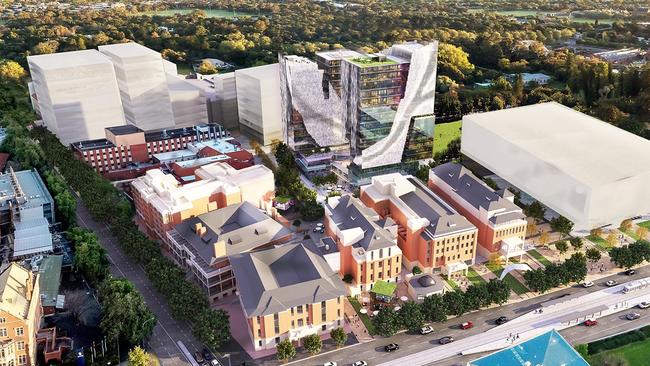World’s leading computer science university MIT stakes claim in Adelaide’s Lot Fourteen
World-famous university MIT will be an integral part of Lot Fourteen, the old hospital site on North Tce — establishing a living laboratory to crunch big data and develop popular products.

City
Don't miss out on the headlines from City. Followed categories will be added to My News.
The world’s leading university in computer science, the Massachusetts Institute of Technology, will build a laboratory at Lot Fourteen to drive innovation by crunching massive amounts of data.
Adelaide was a prime location “due to its leadership in data analytics and machine learning”, MIT Professor Alex “Sandy” Pentland said. The Living Laboratory will bring together students, researchers and commercial interests.
They will trawl through data from mobile phones, banking services, government transactions, GPS tracking, satellite imagery and other sources.
Working with BankSA, Optus and the State Government, it will guide government decisions and develop products with commercial outcomes.
MIT is one of the world’s most successful creators of hi-tech business with companies spawned from its computer research generating revenue of $US2 trillion a year.
“From the things we do, we get several spin-off companies every year,” Professor Pentland said.
The Living Lab will be an incubator, identifying where opportunities are and having young people involved who can then seize the chance to build a business with partnership of big business.
Premier Steven Marshall said attracting MIT to Lot Fourteen, which is the old RAH site, was “an absolute coup for South Australia”.
“Data is the future,” he said.
“The data we are getting in now will inform decision making for government projects, industry projects and future prosperity. It will improve productivity and, most importantly, create more jobs right here in SA.
“It will bolster entrepreneurial activity across a range of industries.”
BankSA and Optus are major funders of the project and will move staff into the laboratory while MIT will rotate researchers and students through Adelaide.
MIT will work with the three main universities on projects and establish exchange programs for students between the US and Adelaide.
BankSA chief executive Nick Reade said it was the bank’s most expensive sponsorship deal and a unique opportunity.
“It’ll be a small group of people with a big impact,” he said. “This is about researching, analysing and creating interventions to create jobs. The power in the Living Lab lies in being able to pinpoint what the roadblocks are and generate valuable insights to propel the state forward.”
BankSA augmented intelligence specialist Irene Prodromou will be among the first people to work at the lab.
“It’ll be a tech hub for Australia,” she said.
BankSA is the principal sponsor of the Adelaide Fringe and Mr Reade said data crunching at the lab would help make the Fringe even more successful.
Instead of only having audience surveys to guide investment choices, anonymous but accurate data would plot exactly what was working or not.
Mr Marshall said the State Government would make available data it collected from the public.
It would be de-identified with individual privacy safeguarded and then collated with other data sets from other sources.
“The more data we get in, the more information we can crunch, the better outcomes we’ll be able to create,” he said.
Professor Pentland said aggregating data from lots of different sources would help government and business recognise trends and plan better.
He cited the example of buses saying under a poor bus service, commuters might be late for work, ultimately affecting employment.
With much better data on usage by times and numbers and whether timetables were met, planners could provide the best, timely services, he said.
Commercial operators made better decisions with more complete information: “They know where to put their warehouses, they know where to run their delivery trucks, they know what communities are likely to shop here or shop there.”


Optus Business managing director Simon Vatcher said the project would “tap into emerging markets and opportunities and satisfy the evolving needs of customers”. “The fastest way to learn is to be here and learn from each other,” he said.
Momentum is accelerating at Lot Fourteen with about 250 people working on site already and 400 contractors engaged in demolition and refurbishment.
The MIT Living Laboratory will be on North Tce in the old Allied Health Building.
MIT is based in the US city of Cambridge, across the Charles River from Boston.
Its presence will add to Adelaide’s reputation as a leading education city.
As well as the three mainstream universities — Adelaide, Flinders and UniSA — Adelaide is home to a satellite campus of Carnegie Mellon and to Torrens University which is part of the Laureate International Universities network.
University College London operated an Adelaide campus until 2017 and retains a partnership with UniSA.

The MITbigdata Living Lab will add to a growing list of companies and organisations at Lot Fourteen.
The Australian Space Agency will occupy the old McEwin Building which has been gutted and is now being refurbished. The agency will manage a Mission Control facility and a Space Discovery Centre which will be open to the public.
The SmartSat CRC and the University of Adelaide’s Institute of Machine Learning will also have major presences on site.
Lot Fourteen already has a number of start-up and medium-sized companies on site as it attracts firms working in its strategic themes of space, defence, cyber security and creative arts technology.
These include satellite communicator Myriota, space tracker Inovor, rocket propulsion developer Neumann Space, life science company Presagen, IT consultants Chamonix, augmented intelligence researcher Datium and a raft of creative arts firms headed by Anton Andreacchio.
Satellite maker Fleet Space Technologies also will take space in the precinct.
Lot Fourteen will be home to an international centre for tourism, hospitality and food studies, an Innovation Centre tower building for start-up companies and the Aboriginal Art and Cultures Gallery — which was allocated $150 million in the recent State Budget.


